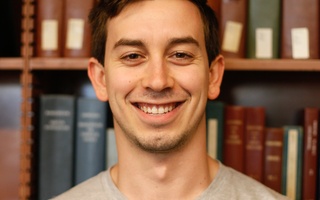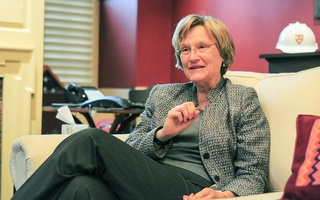{shortcode-0dde0e35f628655ee21ae52728e2cfd02c9b180b} “We won’t die for the price of gas; Uncle Sam go kiss my ass!”
In December of 1990, covered in scarves and hats to battle freezing temperatures, students and other activists protested the United States’ military presence in the Persian Gulf, chanting this slogan while marching down Massachusetts Avenue, blocking traffic and placing stickers on an armed forces recruiting station as they went.
“It was a bunch of people, enough to shut down Mass. Ave. traffic, singing and chanting,” John G. Neffinger ’93 said. “The anti-war protesters were an interesting mix of town and gown… We engaged with the broader community.”
One month after the protest, war erupted in the Gulf as U.S. troops invaded Kuwait, commencing Operation Desert Storm against Iraqi forces. For the first time since Vietnam—a full generation earlier—the United States was involved in a major foreign military offensive, this time on the side of Kuwait and against Saddam Hussein’s authoritarian regime.
Understanding that negative perceptions of American military operations were largely shaped by the war against the northern Vietnamese two decades earlier, then-U.S. President George H. W. Bush promised that the action in the Gulf would “not be another Vietnam.”
“I have said this before and I repeat this here tonight, our troops will not be asked to fight with one hand tied behind their back. Our troops will have the best possible support,” Bush said in a televised address that January.
Bush was right; his strategy of using overwhelming force worked, and the actual combat lasted barely more than a month, ending February 28, 1991.
For almost all the members of the Class of 1991, the Gulf War was the first major U.S. military operation in their memory, coming just after the end of the Cold War, with the U.S. as the leader of the new world order.
To some students, the war was like a flash in the pan, seemingly over before it started. To others, the intervention was an important event that signaled what role the U.S. would play in world affairs in the coming years. Two groups—Students United for Desert Storm (SUDS) and Students Against War in the Middle East (SAWME)—followed the war closely, organizing protests and counter-protests.
The Vietnam War ended in 1975, nearly 16 years before the Gulf War and while most members of the Class of 1991 were barely entering primary school, the shadow Vietnam cast remained a salient issue in determining how students and the public viewed the Gulf War.
“My generation, when we were students, we never experienced the Vietnam War; that was our parents. So, we were kind of deer in the headlights,” Lyle J. Goldstein ’94 said. “The 1980s—there was the period of Reagan, we were kind of marinated in the Cold War, there was this resurgence of American power—so there was some excitement about the idea that there was this new world order… and we had to make sure that this new world order got off on the right foot.”
In fact, a 1990 Crimson article entitled “War Worries” pointed to this comparison between the Vietnam and Gulf wars.
“The comparisons were inevitable,” Jonathan S. Cohn ’91, the article’s author, wrote. “As soon as President Bush ordered troops to the Persian Gulf this summer, some critics said the engagement would be another Vietnam. And as soon as activists started their campus protests this fall, some would-be historians hailed the '90s as a revival for the New Left.”
“There was a very large proportion of the student body paying attention [to the Gulf War]. First, it was the first major conflict for the country since Vietnam,” Harry J. Wilson ’93, SUDS co-founder, said. “Second, it was the first major conflict on modern cable news.”
Adam D. Taxin ’93, the other co-founder of SUDS and a former Crimson editor, described popular concern that the Gulf War “would be like the ‘60s, eventually” in that some feared the U.S. would be dragged into a long conflict like Vietnam.
In addition to the Vietnam War, other 20th century wars also set a precedent for U.S. military endeavors.
“You have the great war, World War Two, as the war we’re always striving toward, but then the other huge one is Vietnam. Korea is sort of a non-event in there, and there were some other skirmishes,” Neffinger said. “There’s the good war and the bad war, and the bad war was much more recent.”
Harvard’s Institute of Politics hosted a debate between SUDS and SAWME on the U.S. presence in the Gulf War on February 26, 1991.
Two days before the conflict’s end, the event “was packed to overflowing, with people standing up and yelling,” Neffinger, one of SAWME’s representatives in the debate, said.
“There were also some students from Kuwaiti royalty or aristocracy,” he said. “They stood up in the audience and they were shouting at us, at SAWME, and I just remember finding that so outrageous that they felt self-entitled to have basically high school-age kids from around middle America go to the Middle East and put their lives on the line to give these oligarchs their riches back.”
In addition to formal debates and organized events such as teach-ins, students also organized pro- and anti-Gulf War demonstrations.
“We had hundreds of people come to our rallies and the other side had hundreds of people, as well,” Wilson said.
However, in a 1991 Crimson article, Mica Pollock ’93, who was a member of SAWME, emphasized that SAWME, rather than protesting the soldiers who are fighting in the war, was opposed to the “concept of war” and the policymakers who supported U.S. military involvement.
"In this anti-war movement, people see a clear division between soldiers who are fighting the war and the people who sent them there," she said at the time. "We are protesting against people who sent them."
“[T]here was general sentiment to ‘support the troops’ and avoid making targets of military service providers,” Thomas I. Savage ’91 wrote in an email. “People were sensitive to rough treatment some Vietnam war vets experienced upon returning home and wanted to treat the Gulf war vets better.”
While some students were outspoken in supporting their respective causes, some Harvard affiliates, such as former City Councillor Kenneth E. Reeves ’72 criticized students for their “tepidness” and acceptance of the U.S. power structure.
In a different Crimson article, Cohn wrote that activists who lived through the 1960s were often “not impressed with this recent show of student force” and that students during the Gulf War had “far to go before they [could] meet the standards set by their flower-child parents.”
“While there were some people expressing either support or opposition to the war, demonstrations were muted,” Savage wrote.
Some attributed lackluster student response to the brief time span of the U.S. intervention in Kuwait.
“We didn’t know it was going to be such a short war,” Taxin said. “In retrospect it seems silly given how short the whole thing was… Everything occurred so quickly that there wasn't a chance to do anything other than to say ‘support the troops.’”
Furthermore, before war broke out, “people were concerned there would be a lot more killed” in military action, according to Goldstein.
Yet, the number of U.S. casualties in battle during the Gulf War was the lowest of any major U.S. conflict. According to the U.S. Department of Veterans Affairs, 148 American soldiers died in combat compared to over 47,000 deaths during the Vietnam War.
“If you go back to that time, the issues that everyone was talking about were the collapse of the Soviet Union and the unification of Germany and the Berlin Wall,” Goldstein said. “Those were the issues that were on everybody's mind. This one was kind of a flash-in-the-pan moment.”
—Staff writer Nathaniel J. Hiatt can be reached at nathaniel.hiatt@thecrimson.com. Follow him on Twitter @nathaniel_hiatt.



